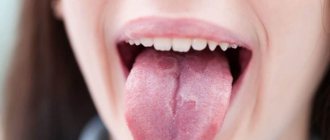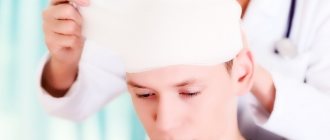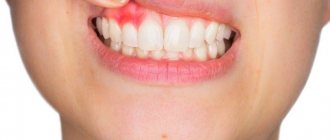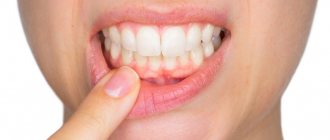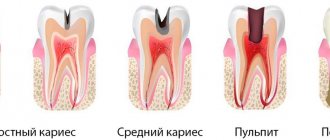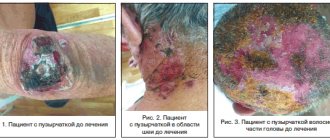Neck pain that radiates to the head is a common problem among people of any age. It is often accompanied by problems with neck rotation and headaches.
The fact that people have pain in the back of their neck and radiate to their head becomes a common cause of many troubles in life.
Pain in the back of the neck and radiates to the head
In this article we will look at the causes of pain, its diagnosis and treatment.
Treatment
After diagnosis, depending on the causes of pain in the ear area, the specialist prescribes treatment. Therapy may include the following medications:
- prescription muscle relaxants;
- antidepressants;
- steroid drugs and blockers;
- antisecretory drugs;
- antibiotics.
When the cause of the illness is neurological diseases, the patient is shown:
Surgical intervention is required in rare cases, in the presence of serious pathologies, when other methods are ineffective. In such a situation, the following types of surgical treatment can be performed:
- stimulating the occipital nerve to block signals sent to the brain;
- microvascular decompression, which is done to change the location of the vessels that compress the nerve endings, which leads to pain.
As a rule, when treating headaches in the ear area, surgical intervention can be avoided, and the patient feels relief after taking the prescribed medications and performing the necessary procedures.
Ways to fight
First of all, the patient needs to normalize the immune system. To do this, many, even completely healthy people, use well-known vitamins. The next criterion is a healthy lifestyle; every patient and healthy person should engage in physical therapy. It doesn't take much time, but it's a really effective way to prevent headaches.
At home, special infusions are widely used that eliminate pain in the ears, eyes and head. However, experts strongly recommend consulting a doctor, since similar symptoms are inherent in various diseases, sometimes life-threatening. The advanced state of the disease is much more difficult to treat.
Otitis and its types
As a rule, otitis may appear due to complications of infections occurring in the body or develop independently. The most dangerous types of illness are considered internal and middle, because they can damage the eardrum and affect the quality of a person’s hearing, which cannot be restored.
Otitis may appear if the patient does not take good care of the hygiene of his ears, cleans them with foreign objects such as a pencil or straw, bathes in contaminated water, or if his body is weakened due to a lack of vitamins or seasonal diseases.
Let's look at the symptoms of otitis media. Signs of this disease include:
- Pain and swelling of the ear, which intensify with palpation.
- Presence of pus in the ear canal.
- Changes in the general condition of the body, increased temperature, and the appearance of lethargy.
- Analgesics do not eliminate pain; the pain is most often throbbing.
- Hearing decreases on the affected side.
- If the disease also affects the inner ear, in other words, if a person begins to develop labyrinthitis, hearing is significantly reduced until it is lost, the person feels nausea and dizziness.
To cure any type of otitis, it is necessary to use broad-spectrum antibiotics, as well as medications that relieve swelling and relieve inflammation.
Etiology of the phenomenon
Intoxication of the body can occur both due to external damage or inflammation, and due to internal formations. Painful sensations sometimes change their location. There may be a headache behind the ear, or the pain is localized above the hearing organ itself
In addition, the pain syndrome can have an increasing or decreasing character, which is also important for diagnosis
Another type of disease and accompanying pain is associated with tissue damage of a pathological nature. A striking example of this is purulent formation. A similar lesion is localized directly in the ear, but the pain is radiated to the head. In such cases, it is necessary to find the source of pain, since rupture of the purulent sac threatens blood poisoning. The pain in the head is sharp and throbbing, and it can also increase depending on the position of the body.
Predisposing factors
Even a person’s lifestyle can become the impetus for the development of such diseases and symptoms. Certain areas of the spinal column hurt when staying in one position for a long time. Pain can be felt not only in the spinal muscles, but also in the head and ears.
There are certain factors that provoke these diseases:
- When climate conditions change, people often complain of a headache behind the ears.
- Pain in the eyes is felt with long-term use of modern devices, or rather gadgets.
- Overstrain of ligaments and muscles.
- Pathologies associated with disorders in the spinal system.
- Heart attacks, strokes.
- Stress.
No matter how trivial it may sound, even food can cause a person to have a headache behind the ears. For example, an excess of glutamate monosodium causes pain behind the ears, in the temporal part, in the eyes, etc.
A number of foods that cause headaches:
- preservatives;
- spices, sauces, seasonings;
- a range of potato dishes;
- nuts and their kernels (especially fried);
- smoked fish, bacon and others.
Prevention of ear diseases
Some people mistakenly believe that to prevent various diseases of the hearing organs, it is enough to just regularly wash them and clean them with cotton swabs. However, this is not at all true.
As a rule, after washing your hair, you need to blot your ears with a towel, since the moisture in the ears is not completely removed with cotton swabs and becomes a breeding ground for microbes.
Avoid picking your ears with foreign objects such as a pencil, paper clip, or even a toothpick. Even cotton swabs, although considered safer, can cause some harm. The fact is that they clean the auricle, but also relieve it of the protective layer that prevents the growth of bacteria.
Therefore, from time to time it is necessary to use antibacterial drops, which can be bought at the pharmacy. They help get rid of moisture inside the ears and get rid of bacteria.
So, you cannot clean the ear canal with cotton swabs and try to get rid of the plug, as it will make the wax more dense and it will not be so easy to get rid of it. The sticks are only suitable for cleaning the outside of the ears, not the inside.
But these are not all the rules that must be followed to avoid hearing diseases.
It is necessary to wear a hat, no matter how hackneyed it may sound, so that your ears are protected from winds and cold, this is especially true in winter weather.
Monitor your health and prevent the possible spread of infection or inflammation during colds. After all, even such seemingly harmless diseases as influenza or acute respiratory viral infections can become complicated, which will also affect the ears.
It is necessary to visit an otolaryngologist and undergo a preventive examination, even if a person feels fine and does not experience any discomfort in the ear area. If symptoms appear, you should seek help immediately.
Features of pain syndrome
Many diseases of the head, neck, blood vessels, muscles and ligaments of the spine are characterized by the appearance of discomfort in the parotid area.
Inflammatory processes
In case of inflammation of the ear itself (otitis externa), mild pain is accompanied by redness of the skin of the auricle and external auditory canal, discomfort when chewing and pressure on this area. The pain may become more severe when the concha is retracted during the formation and maturation of a boil in the external passage, narrowing the lumen of the canal. With otitis media, the pain syndrome is severe and has a shooting character. Patients, and more often these are children, cannot sleep, complain of severe pain in the left or right side of the head, radiating to the ear, discharge from the ear canal of various types from simple serous to purulent. This condition requires emergency medical attention.
A severe complication and the cause of severe pain reactions behind the right or left ear is mastoiditis (inflammation of the mastoid process). The pathology is accompanied by suppuration from the ear canal, sharp pain on the right or left behind the ear, especially when tapping on the process, swelling of soft tissues, redness of the skin in this area, hyperthermia (increase in temperature to 39-40 degrees), deterioration in the patient’s well-being, and insomnia. Adult patients complain that the bone behind the ear “hurts.” The disease requires emergency assistance from an ENT doctor and massive antibacterial therapy. Mastoiditis in the worst cases of its development will lead to paralysis of the facial nerve, breakthrough of pus through the molten bone plate into the soft tissue behind the ear with the formation of an abscess or into the posterior cranial fossa involving the meninges, sepsis.
Sinusitis will be manifested by bursting pain in the projection of the corresponding bone sinuses, purulent nasal discharge, increased temperature, and deterioration of olfactory processes.
Lymphadenitis in the cervical and occipital region is characterized by the presence of an enlarged, painful spherical formation that occurs against the background of inflammation of a nearby organ. Inflammation of the node causes headaches, poor health, and an increase in body temperature to 37 -38 degrees and above.
With inflammation (mumps, including epidemic) and the formation of stones in the salivary glands, the pain will be localized behind the ears, accompanied by swelling of the gland, and retraction of the auricle forward.
Joint diseases
A common cause of pain behind the ears on the right and left is osteochondrosis of the cervical spine - cervicalgia (literally “pain in the neck”). Symptoms intensify when tilting the head, turning the neck and head to the right and left, often accompanied by a crunching, “stretching” of the neck muscles. The disease can begin with a “lumbago” in the back of the neck (forced position of the head and sharp pain that limits movement in the cervical spine).
If we are talking about damage to the temporomandibular joint, the pain is not clearly expressed, is felt more in the left or right temple, intensifies with chewing movements, when pressing on the joint, a characteristic “click” or crunch is heard.
Neurological diseases
Pain syndrome with trigeminal neuralgia is one of the most severe among similar diseases. On the left or right side of the lesion, most often in the projection of the lower jaw, numbness and severe shooting pain in the head appear, which is provoked by hypothermia or a stressful situation. Symptoms appear on the right or left in one half of the face, frontal, occipital area, ears, cheekbone and temple area, masticatory muscles. Sometimes a “distortion of the face” (distortion by pain) occurs.
Migraine is manifested by extremely severe pain on the scale of sensations and is caused by poor diet, stress, and hypothermia. The pain affects only one half of the head, is aggravated by touching the hair or skin, noise, bright light, turning the neck and other movements, and is often accompanied by nausea and vomiting.
Other reasons
Pain as a result of dental caries will be associated with involvement of the trigeminal nerve on the affected side. Increasing sensations upon contact with a damaged tooth or pressure on it can indicate a problem with the health of the teeth and oral cavity.
A wax plug is formed due to the difficult passage of thick earwax. At the time of its formation, there is usually no pain. There is discomfort when pressing on the tragus, a feeling of congestion in the ear canal, and decreased hearing on the side of the plug. In this case, you need to contact an otolaryngologist, but “time is of the essence.”
Diagnostic methods
For headaches that affect the ear area, it is important to undergo a timely examination and determine the cause of the alarming symptoms. At the initial examination, only visible disorders are determined, including inflammatory processes, fever and other signs. However, to get a complete picture, additional examinations will be needed:
- clinical and biochemical blood tests - these data will indicate infectious processes, pathologies of the hematopoietic system, as well as disruption of the functioning of internal organs;
- bacterial culture if purulent inflammation is suspected - will allow you to identify the pathogen and select an antibiotic to which the bacteria are sensitive;
- Dopplerography - ultrasound diagnostics of blood flow in the vessels of the neck and head, prescribed to detect areas of ischemia;
- MRI or CT scan of the head – often used when tumors in the brain are suspected;
- consultations with specialized specialists – dentist, otolaryngologist, neurologist.
The Clinical Brain Institute has precise, high-quality modern equipment, which makes it easy to make the correct diagnosis in a short time. Here you can take blood tests and other biological fluids, and undergo an examination of the brain and cervical spine. Qualified specialists will help you decipher test data and identify any pathologies in the early stages.
Treatment options and complications
Correct diagnosis means effective treatment and favorable prognosis!
It is impossible to unambiguously determine the method of treatment without establishing an accurate diagnosis. That is, the therapeutic method is prescribed based on the cause of the headache:
- if the cause is a viral or bacterial infection, it is necessary to take antiviral drugs and antibiotics (Amiksin, Laferobion, Amoxiclav, Albucid)
- if your head hurts because of a tooth, then you need to visit the dentist and fix the problem
- for osteochondrosis, massages and the use of local drugs are necessary, the action of which is aimed at the regeneration of osteochondrosis tissues
- if your head hurts due to inflammation of the lymph node, then you need to take a drug that increases the immunity and protective functions of the body
During the treatment of any pathology, dietary nutrition, smoking cessation and alcohol consumption are required. The doctor prescribes the exact medications, but self-medication is highly discouraged, as this can aggravate the situation.
More information about mastoiditis can be found in the video:
As for prognosis and complications, it is difficult to speak in general terms without an accurate diagnosis. The only thing that can be said unequivocally is that the sooner the cause is determined and treatment begins, the greater the chances of avoiding the development of complications.
In medical practice, there have been many cases where patients self-medicated and treated a cold while they developed an oncological tumor.
There are no preventive methods against headaches. You can only protect yourself from possible pathologies. To do this, it is necessary to undergo a medical examination by specialists annually (1-2 times) in order to identify the disease at an early stage.
In addition, it is important to pay special attention to the immune system. It is important to adjust your diet, avoid fatty, salty, sweet and spicy foods. Introduce more grains, fresh berries, herbs, fruits and vegetables into the menu
Introduce more grains, fresh berries, herbs, fruits and vegetables into the menu.
Noticed a mistake? Select it and press Ctrl+Enter to let us know.
According to statistics, cephalalgia is rarely caused by diseases of the brain. In most cases, it occurs as a result of decreased vascular functionality, nerve damage, and pathological processes in the ENT organs. But this does not mean that there is no cause for concern. If you have a severe headache on the right side of the ear, or the symptom appears with enviable regularity, it is necessary to carry out a diagnosis under the supervision of a specialist. An alarming sign is an increase in symptoms when changing body position or external conditions, for example, temperature changes.
Neuralgia of the facial nerve
Inflammation of the lower branch of the trigeminal nerve leads to pain behind the ear that intensifies when pressed.
© shutterstock
Causes
The inferior branch of the facial nerve is responsible for innervation of the lower part of the face, palate and tongue. The cause of damage to the nerve root will be :
- hypothermia;
- complications after dental procedures (abscess or flux);
- inflammation of the gums;
- stomatitis;
- facial injuries.
An inflammatory process in the muscles of the lower jaw can also provoke the development of neuralgia.
Symptoms
Pain behind the ear causes:
- pressing;
- swallowing;
- movement of facial muscles during conversation.
The severity of symptoms depends on the severity of the nerve damage.
In mild cases, pain behind the ear will appear only when pressing and moving the muscles, and at rest, patients do not feel discomfort.
In severe neurological conditions, it hurts constantly, and when pressed, the pain will intensify.
Treatment
When the reason that the back of the ear hurts when pressed is facial neuralgia, patients are prescribed:
- NSAIDs;
- analgesics;
- ointments with analgesic and anti-inflammatory effects.
Additionally, the provoking disease is treated.
If the cause is stomatitis, then antifungal therapy is indicated.
For abscesses and phlegmon, the ulcers are opened and a course of antibiotic therapy is administered.
Where to go
Which doctor to visit first depends on the cause of neuralgia. If the disease is caused by dental pathologies, you need to start with a visit to the dentist. For facial bruises, a traumatologist conducts an examination. And if you have pain behind your ear after hypothermia, then a neurologist will help .
Pain occurs behind the ear for various reasons and almost always they turn out to be signs of a serious pathological process. You should not ignore the condition that has arisen - timely seeking help will avoid complications.
© shutterstock
Sulfur plug
A wax plug forms in the ear due to the specific structure of its outer part and insufficient care for it. As a rule, it is removed if it has managed to completely fill the outer area of the canal and has caused partial hearing loss. A person with an ear plug cannot hear in only one ear, which is damaged, but the condition of the whole body remains normal.
Trying to clean the ear canal yourself using improvised means, such as a hairpin or a match, can only thicken the earwax, especially if the period between cleanings has been long. A special stick is only suitable for cleaning the outer part of the organ.
In order to get rid of cerumen and pain in the head behind the ear on the right, you need to use plain water. As a rule, the doctor draws a little liquid into the spitz and releases it under pressure, which is why the unwanted seal comes out.
What to do and how to treat
You should not try to cure this symptom on your own. After all, you don’t know the true cause of pain. The best way out is to consult a specialist doctor. After carrying out all the necessary diagnostic procedures, you will be prescribed adequate treatment, which will lead to the disappearance of the discomforting symptom.
Thus, ear pain can occur for completely different reasons. It is almost impossible to independently determine the source. The fate of further therapeutic intervention depends on the correct diagnosis: whether it is possible to manage with conservative therapy or whether it is necessary to resort to the use of invasive intervention.
Why does cephalalgia occur in the back of the head?
1. Spondylitis, osteochondrosis, dislocation of small joints between the vertebrae, sprains that were received as a result of injury to this department. In this situation, the unpleasant sensation is localized directly in the back of the head and neck. When moving, the pain intensifies, it can radiate to the ears, nausea, noise, ringing, and congestion occur.
2. Nervous tension. Why does this happen? This deviation occurs in the patient due to stressful situations. To a greater extent, cephalalgia in the back of the head with this disorder appears in the female half of the population, after 25 years. In this state, the following symptoms are noted: noise, ringing in the ears, dizziness, noise, it seems that something is pressing on it, and nausea occurs. Some people note that when they are stressed, their ears also become blocked. It is worth considering that symptoms may differ for each person and may manifest themselves partially.
3. Overwork. In most cases, it happens when a person is very tired due to prolonged stress of a different nature, or being in an uncomfortable position. The result is unpleasant sensations in the back of the head, nausea, dizziness, and stuffy ears.
4. Cervical spondylosis. Diagnosed in elderly patients, as well as in mental workers. It manifests itself as pain in the back of the head, shoulders, eyes, especially when stationary for a long time. Poor neck mobility is also noted. Insomnia, noise, ringing in the ears may occur, sometimes they become blocked, the head is dizzy, and when blowing the nose, pain radiates to the back of the head.
5. Myogelosis is a disease associated with stiffening of the neck muscles. Can be triggered by many factors. Symptoms of the pathology: pain in the back of the head, near the shoulders, increased stiffness in movements, dizziness, in rare cases, patients may also complain of ringing and noise.
6. Neuralgia of the occipital nerve. In this situation, the pain is periodic and spreads to many parts of the body. It also rings, makes noise in the head, and stuffs up the ears. Ringing and noise occurs when the patient twists his neck.
7. Arterial hypertension. Provokes pain in the back of the head, especially in the morning.
8. Cervical migraine. The patient in such a situation complains of tinnitus and hearing loss, dizziness.
9. Prolonged muscle tension. Why does this happen? This condition is diagnosed when physical exercises are performed incorrectly, which causes tinnitus and a nagging, unpleasant pain in the back of the head, which can radiate to the forehead.
Most of the pains that have been listed are bilateral and localized in different places. Basically, cephalalgia is accompanied by nausea and vomiting. Why does this happen? Because due to intense pain, the patient’s body is exhausted. In case of prolonged attacks, as well as those that are often repeated, you should contact a specialist who can accurately determine the cause of the poor condition and prescribe effective treatment.
Therapy for pain is prescribed based on the results of diagnostic examinations:
1. Clinical and general blood test. Helps determine if there is an inflammatory process in the body.
2. Electroencephalography. If the examination is carried out during a migraine, changes will be noted on the EEG.
3. Magnetic resonance imaging. Determines the presence of a tumor in the brain, which provokes cephalgia in various parts of the head.
4. Echo of EG. Helps determine the position of brain structures and their displacement.
5. Dopplerography. Helps to carefully study the blood circulation in the vessels and what changes have occurred.
6. Radiography. Conducted to study the skeletal system and joints of the skull.
Neck structure
First, it’s worth talking about the anatomical structure of the neck. This way you can understand how changes occur in the neck area, which become the main cause of pain.
So, the human cervical spine consists of 7 vertebrae. It is worth noting that the first vertebra (atlas) is attached directly to the base of the skull.
Now let's look at the structure of the vertebra in detail.
- Spinous process . This part of the bone can be easily felt on the back of the neck.
- Vertebral body . It is the basis of communication between various cervical vertebrae.
- Intervertebral disc . It is located in the space between two vertebrae.
- Articular surfaces . Considered the second connection between two vertebrae. Both the intervertebral bodies and the articular surfaces are covered with cartilage tissue. This is important because it is the articular surfaces that allow a person to move their neck.
- Intervertebral foramen. It is formed by cuttings of adjacent cervical vertebrae. This hole is the place where nerve fibers leave the neck area. The spinal canal along with the spinal cord is also located there.
- Transverse holes. Blood arteries pass through them.
The structure of the neck is complex in its structure
If you want to find out in more detail how many vertebrae are in a person’s neck, and also consider diseases of the cervical spine, you can read an article about this on our portal.
The muscles in the neck help stabilize it when rocking and keep it level when moving straight.
In most cases, it is the muscles that suffer. Knowing this is very important because it can make it easier to treat neck pain that radiates to the head.
Massage pillow for neck and shoulders
External causes of pain
Ear pain in the area of the lower jaw, neck or temple sometimes occurs in completely healthy people. The reasons for this phenomenon are the following factors:
- Exposure of the ears to sharp cold, strong gusts of wind, or draft. Most often this happens during winter walks without a hat. It is enough to go into a warm room and put on a hat to get rid of cutting pain in the ear, neck or temple.
- Accidental entry of water into the ear canals while swimming or diving. Jumping on one leg with your head tilted to the side will help get rid of congestion.
- The formation of a dense sulfur plug due to the accumulation of sulfur, dust, and small particles of debris. Dull pain at the temple or at the level of the lower jaw will go away only after cleaning the ear canal and removing the plug by rinsing.
- An insect, small foreign object, or debris gets into the ear. If you cannot remove the object yourself, you must consult a doctor for examination and medical procedures.
If these external causes are not eliminated, inflammation of the ear canal may begin. Long-term treatment will be required due to various complications. Sometimes the cause of pain in the lower jaw or neck is headaches, runny nose, and colds. Most often, only a doctor can exclude symptoms of disease through a detailed examination.
Pain over the hearing organ
Another equally common complaint is pain in a specific area of the head. At appointments, doctors often hear that the patient has a headache above the ear. Typically, patients ignore such pain for a long time, but when it occurs frequently, they are forced to seek help.
Pain above the ear is felt in certain neurological pathologies:
- Throbbing pain that affects the auditory and visual organs indicates an advanced migraine.
- When a boil appears on the auricle, the pain spreads along the sides of the skull, mainly behind or above the ear.
- With otitis media, the pain is throbbing and there is a feeling of inflammation in the ear area.
- With disorders in the temporomandibular joint, pain spreads along the jaw and radiates to the ear and eye areas.
Why does it hurt behind the ear on the right?
"I have a headache!" is one of the most common complaints among people of different ages, gender and lifestyle. Like the causes, the localization of pain can also be different - the whole head can hurt, as well as individual areas - the forehead, the back of the head, the top of the head, the area behind the ears.
“I have a headache on the right side of my ear!” - this is a signal of more serious reasons than simple fatigue, lack of sleep or a cold. In this case, opposite areas (right and left side) may indicate different sources of pain.
Despite the apparent simplicity of the definition, identifying what exactly is the cause of pain behind the right ear is quite difficult. To get qualified help in this matter, you need to contact a specialist. You should not expect an immediate solution, since this symptom can be a sign of several diseases.
Cephalgia pressing on ears
Quite often, specialists hear from patients that they have a headache and pressure on their ears. Typically, such pain is accompanied by tinnitus, a feeling of nausea and dizziness. This is usually caused by congestion in the ear. There is no need to panic when such symptoms are detected, since diseases characterized in this way are rarely serious and often go away after taking painkillers. However, in the initial stages it is very important to correctly diagnose pathologies.
In addition to all the above symptoms, which doctors pay special attention to, this category may include other manifestations of serious illnesses:
- Disorders in the cardiovascular system.
- Fluctuations in blood pressure.
- Microstrokes.
Causes and possible diseases
Pain in the head on the left side above the ear is a symptom of a number of diseases!
Headache is a problem for all people. The thing is that if your hand hurts, then it’s a hand disease, but if you have a headache, it can indicate any disease in the body. If pain occurs above the ear on the left, this may indicate various pathologies. Different types of pain may indicate different causes.
Let's look at the main causes and diseases that can cause headaches on the left side:
- Otitis is an inflammatory process of the ear, which can occur as a complication after an infectious disease or as an independent pathology arising due to the development of pathogenic microorganisms. In this case, severe pain occurs in the ears, radiating to the head above the ear. In addition, there are other symptoms - discharge from the ears, clicking sounds when swallowing, increased body temperature
- lymphadenitis (inflammation of the lymph nodes) is not an independent disease and occurs most often at the onset of an infectious disease
- Mumps (mumps) is an infectious pathology caused by paramyxovirus. The main symptom is inflammation of the salivary gland, which causes pain in the head above the ears. In this case, general weakness occurs and the temperature rises. This disease requires immediate treatment, as it has many complications (pancreatitis, meningitis, infertility)
- damage to osteochondral tissues and muscle mass. Most often, osteochondrosis impairs blood circulation, which impairs the supply to the cerebral cortex. This is what causes pain above the ears.
- sinusitis, rhinitis, tonsillitis, influenza - these diseases are localized in the upper respiratory tract. They affect the nasopharynx and throat. When the nerve endings are affected, the pain radiates to the head, and specifically to the ears and above.
- toothache, especially if the roots of the upper teeth are affected, pain may occur in the ears and above the ears
If there is prolonged pain in the head above the ear (2-3 days), you should consult a doctor to get examined. The doctor will prescribe a series of tests and will be able to formulate a course of treatment.
Serious reasons
Mastoiditis most often occurs as a complication of acute otitis media
Mastoiditis is one of the most unpleasant diseases that can manifest itself as a headache on the left side above the ear. The disease affects the process of the temporal bone, which is located directly behind the ear. Often the pathology develops as a complication of otitis media.
Mastoiditis must be treated, as it can develop into more serious diseases:
- a purulent labyrinth that occurs in the auditory labyrinth, in which the soft tissue begins to rot. Exposure to pathogenic microflora can lead to complete hearing loss
- Meningitis is an inflammatory process that occurs in the brain. Its consequences can be unpredictable, depending on the location of the pathology. Often, after such a disease, a person remains disabled (muteness, deafness, loss of vision, impaired coordination, memory, speech, epilepsy, etc.)
- A brain abscess is a lesion of the gray matter itself. This can cause problems, just like with meningitis. Deaths have been recorded in medicine
Due to the fact that the cause of a headache above the ear can be either an innocent cold or serious injuries, it is recommended to immediately seek help from medical professionals so that it is not too late. In the case of a serious illness, it is better to identify the pathology earlier and begin to treat it.
When a tumor occurs, it grows and begins to come into contact with all parts, resulting in a painful sensation.
Pain in the head and ear
Specialists are faced with various types of patient complaints. So, for example, a patient may say that part of his head and ear hurt. Sometimes such symptoms are pulsating or pressing in nature. International statistics have already identified a number of diseases with similar symptoms:
- Infectious diseases. The infection enters the body through the respiratory tract and can also progress in the oral cavity.
- Migraine. The patient experiences weakness and irritability, moreover, he has a headache behind the ears, above the ears, unpleasant sensations cover a certain side of the face and radiate to the eyes.
- Cluster pain. They were discovered in medicine quite recently, which means that they are still far from being fully studied. Most medications do not give a positive result, but the patient feels much better when he is in a quiet, calm environment.
- Osteochondrosis. In addition to the fact that the patient says that he has a headache in the ear area and part of the face, pain also affects the back of the head and the cervical vertebrae.
Parotitis
Inflammation of the parotid salivary glands, that is, mumps, is characterized by an acute onset with a rise in body temperature to 39 C and the appearance of swelling behind the ear. It is this swelling that is the source of pain and discomfort. In this case, pain can occur both when pressing on the swelling itself, and when opening the mouth, swallowing or chewing. It can spread to the ear and neck area. The process of inflammation can be unilateral or bilateral, but it always begins with one ear.
It is better to be treated according to the doctor’s prescriptions, since parotitis can cause complications in organs that are important to us, such as the pancreas and genitals.


